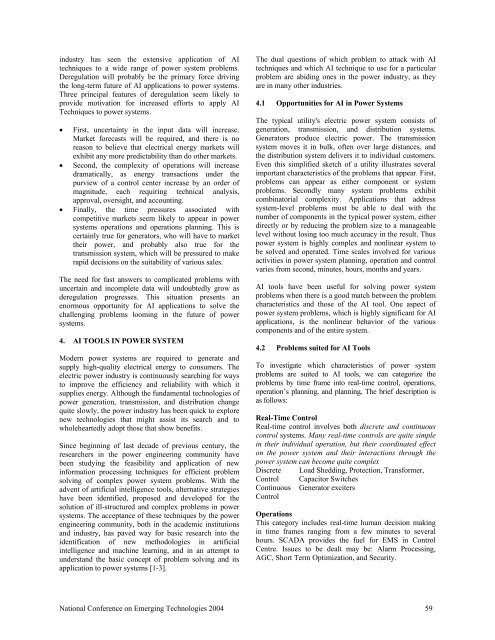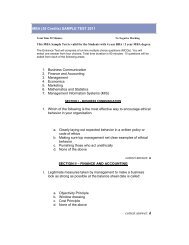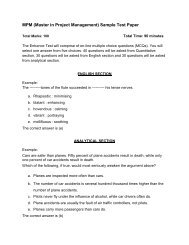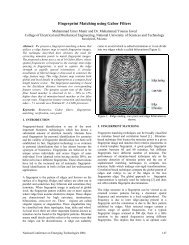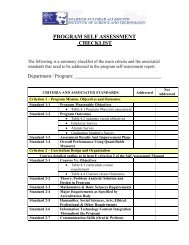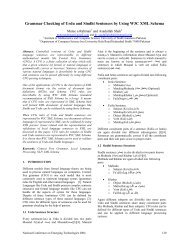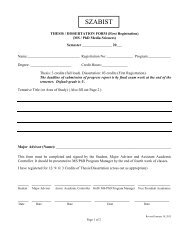Potential of Artificial Intelligence (AI) Techniques for ... - CiteSeerX
Potential of Artificial Intelligence (AI) Techniques for ... - CiteSeerX
Potential of Artificial Intelligence (AI) Techniques for ... - CiteSeerX
You also want an ePaper? Increase the reach of your titles
YUMPU automatically turns print PDFs into web optimized ePapers that Google loves.
industry has seen the extensive application <strong>of</strong> <strong>AI</strong><br />
techniques to a wide range <strong>of</strong> power system problems.<br />
Deregulation will probably be the primary <strong>for</strong>ce driving<br />
the long-term future <strong>of</strong> <strong>AI</strong> applications to power systems.<br />
Three principal features <strong>of</strong> deregulation seem likely to<br />
provide motivation <strong>for</strong> increased ef<strong>for</strong>ts to apply <strong>AI</strong><br />
<strong>Techniques</strong> to power systems.<br />
• First, uncertainty in the input data will increase.<br />
Market <strong>for</strong>ecasts will be required, and there is no<br />
reason to believe that electrical energy markets will<br />
exhibit any more predictability than do other markets.<br />
• Second, the complexity <strong>of</strong> operations will increase<br />
dramatically, as energy transactions under the<br />
purview <strong>of</strong> a control center increase by an order <strong>of</strong><br />
magnitude, each requiring technical analysis,<br />
approval, oversight, and accounting.<br />
• Finally, the time pressures associated with<br />
competitive markets seem likely to appear in power<br />
systems operations and operations planning. This is<br />
certainly true <strong>for</strong> generators, who will have to market<br />
their power, and probably also true <strong>for</strong> the<br />
transmission system, which will be pressured to make<br />
rapid decisions on the suitability <strong>of</strong> various sales.<br />
The need <strong>for</strong> fast answers to complicated problems with<br />
uncertain and incomplete data will undoubtedly grow as<br />
deregulation progresses. This situation presents an<br />
enormous opportunity <strong>for</strong> <strong>AI</strong> applications to solve the<br />
challenging problems looming in the future <strong>of</strong> power<br />
systems.<br />
4. <strong>AI</strong> TOOLS IN POWER SYSTEM<br />
Modern power systems are required to generate and<br />
supply high-quality electrical energy to consumers. The<br />
electric power industry is continuously searching <strong>for</strong> ways<br />
to improve the efficiency and reliability with which it<br />
supplies energy. Although the fundamental technologies <strong>of</strong><br />
power generation, transmission, and distribution change<br />
quite slowly, the power industry has been quick to explore<br />
new technologies that might assist its search and to<br />
wholeheartedly adopt those that show benefits.<br />
Since beginning <strong>of</strong> last decade <strong>of</strong> previous century, the<br />
researchers in the power engineering community have<br />
been studying the feasibility and application <strong>of</strong> new<br />
in<strong>for</strong>mation processing techniques <strong>for</strong> efficient problem<br />
solving <strong>of</strong> complex power system problems. With the<br />
advent <strong>of</strong> artificial intelligence tools, alternative strategies<br />
have been identified, proposed and developed <strong>for</strong> the<br />
solution <strong>of</strong> ill-structured and complex problems in power<br />
systems. The acceptance <strong>of</strong> these techniques by the power<br />
engineering community, both in the academic institutions<br />
and industry, has paved way <strong>for</strong> basic research into the<br />
identification <strong>of</strong> new methodologies in artificial<br />
intelligence and machine learning, and in an attempt to<br />
understand the basic concept <strong>of</strong> problem solving and its<br />
application to power systems [1-3].<br />
The dual questions <strong>of</strong> which problem to attack with <strong>AI</strong><br />
techniques and which <strong>AI</strong> technique to use <strong>for</strong> a particular<br />
problem are abiding ones in the power industry, as they<br />
are in many other industries.<br />
4.1 Opportunities <strong>for</strong> <strong>AI</strong> in Power Systems<br />
The typical utility's electric power system consists <strong>of</strong><br />
generation, transmission, and distribution systems.<br />
Generators produce electric power. The transmission<br />
system moves it in bulk, <strong>of</strong>ten over large distances, and<br />
the distribution system delivers it to individual customers.<br />
Even this simplified sketch <strong>of</strong> a utility illustrates several<br />
important characteristics <strong>of</strong> the problems that appear. First,<br />
problems can appear as either component or system<br />
problems. Secondly many system problems exhibit<br />
combinatorial complexity. Applications that address<br />
system-level problems must be able to deal with the<br />
number <strong>of</strong> components in the typical power system, either<br />
directly or by reducing the problem size to a manageable<br />
level without losing too much accuracy in the result. Thus<br />
power system is highly complex and nonlinear system to<br />
be solved and operated. Time scales involved <strong>for</strong> various<br />
activities in power system planning, operation and control<br />
varies from second, minutes, hours, months and years.<br />
<strong>AI</strong> tools have been useful <strong>for</strong> solving power system<br />
problems when there is a good match between the problem<br />
characteristics and those <strong>of</strong> the <strong>AI</strong> tool. One aspect <strong>of</strong><br />
power system problems, which is highly significant <strong>for</strong> <strong>AI</strong><br />
applications, is the nonlinear behavior <strong>of</strong> the various<br />
components and <strong>of</strong> the entire system.<br />
4.2 Problems suited <strong>for</strong> <strong>AI</strong> Tools<br />
To investigate which characteristics <strong>of</strong> power system<br />
problems are suited to <strong>AI</strong> tools, we can categorize the<br />
problems by time frame into real-time control, operations,<br />
operation’s planning, and planning. The brief description is<br />
as follows:<br />
Real-Time Control<br />
Real-time control involves both discrete and continuous<br />
control systems. Many real-time controls are quite simple<br />
in their individual operation, but their coordinated effect<br />
on the power system and their interactions through the<br />
power system can become quite complex<br />
Discrete Load Shedding, Protection, Trans<strong>for</strong>mer,<br />
Control<br />
Continuous<br />
Control<br />
Capacitor Switches<br />
Generator exciters<br />
Operations<br />
This category includes real-time human decision making<br />
in time frames ranging from a few minutes to several<br />
hours. SCADA provides the fuel <strong>for</strong> EMS in Control<br />
Centre. Issues to be dealt may be: Alarm Processing,<br />
AGC, Short Term Optimization, and Security.<br />
National Conference on Emerging Technologies 2004 59


